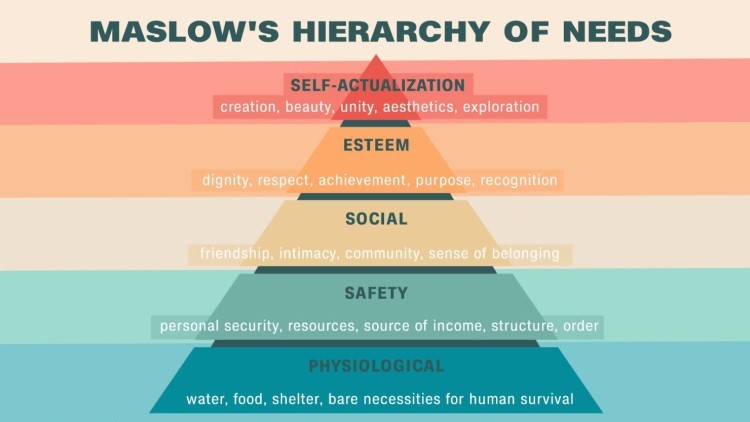
An Introduction to Maslow’s Hierarchy of Needs
Maslow’s Hierarchy of Needs is a psychological theory that explains human motivation through a five-tiered model of needs. Developed by psychologist Abraham Maslow in 1943, the theory suggests that individuals are motivated by a set of hierarchical needs that must be satisfied in a particular order. The hierarchy begins with basic physiological needs, such as food, water, and shelter, and progresses toward higher-level psychological and self-fulfillment needs, such as esteem and self-actualization. According to Maslow, people cannot move to higher levels of the hierarchy until their lower-level needs are met.
The significance of Maslow’s Hierarchy of Needs lies in its comprehensive understanding of human behavior and motivation. It highlights that individuals are driven not only by basic survival needs but also by emotional and psychological factors. This perspective has influenced various fields, including psychology, education, and business, by providing a framework for understanding how and why people prioritize certain goals. For instance, individuals who lack basic security or social connections are unlikely to focus on personal growth or self-actualization, as they are primarily concerned with satisfying their lower-level needs.
Maslow’s theory has become foundational in understanding human motivation, offering insights into how people behave in different contexts. Its application extends beyond individual behavior, influencing areas like employee motivation in the workplace and customer behavior in marketing. By addressing needs at different levels, businesses and organizations can create environments that foster motivation and engagement. Maslow’s Hierarchy of Needs remains a useful tool for analyzing human motivation and continues to be relevant in both personal and professional development contexts.
The Five Levels of Maslow’s Hierarchy
Physiological Needs
Maslow’s Hierarchy of Needs is composed of five levels, each representing a different type of human motivation. At the base of the hierarchy are physiological needs, which include basic necessities like food, water, shelter, and sleep. These needs are fundamental for survival, and individuals must satisfy them before moving to higher levels. Without these basic needs met, it becomes nearly impossible for individuals to focus on other aspects of life.
Safety Needs
The next level is safety needs, which involve physical and emotional security. These include personal safety, financial stability, health, and protection from harm. Once physiological needs are addressed, individuals seek to establish a safe and secure environment. For example, people seek stable employment, insurance, and safe living conditions to ensure a sense of protection and well-being.
Love and Belonging
The third level focuses on love and belonging, where social connections become the primary motivator. Humans have a deep desire to form meaningful relationships with others, whether through friendships, romantic relationships, or family connections. According to Maslow’s Hierarchy of Needs, this sense of belonging is crucial for emotional well-being, and individuals seek acceptance, love, and social bonds as part of this level.
Esteem Needs
At the fourth level are esteem needs, which revolve around gaining respect and recognition. These needs are divided into two categories: self-esteem and the esteem of others. People seek feelings of accomplishment, confidence, and self-worth. Additionally, they desire the recognition and respect of peers and society. Satisfying esteem needs leads to a sense of achievement and status within their personal and professional circles.
Self-Actualization
At the top of Maslow’s Hierarchy of Needs is self-actualization, the desire to reach one’s full potential. At this level, individuals focus on personal growth, creativity, and self-improvement. Self-actualization drives people to seek fulfillment through personal goals, whether artistic, intellectual, or professional. Maslow viewed this level as the ultimate stage of psychological development, where individuals become the best version of themselves.
Applications of Maslow’s Hierarchy in the Workplace
Physiological Needs
Maslow’s Hierarchy of Needs offers valuable insights for improving employee motivation, satisfaction, and productivity in the workplace. By understanding the different levels of needs, businesses can create environments that address these needs, helping employees feel more fulfilled and engaged. For instance, at the base of the hierarchy, ensuring employees’ physiological needs are met involves providing fair wages, proper breaks, and a comfortable working environment. When employees’ basic needs are met, they are more likely to focus on higher-level tasks.
Safety Needs
Next, addressing safety needs is critical for fostering a stable work environment. Employers can ensure job security, provide health benefits, and create safe working conditions, which help employees feel secure in their roles. Financial stability, clear communication about job expectations, and a sense of consistency within the company can further satisfy these needs. When employees feel safe and supported, they are more likely to perform at their best and remain loyal to the organization.
Love and Belonging
To satisfy the love and belonging level, businesses should foster a sense of community within the workplace. Encouraging teamwork, collaboration, and open communication helps employees build meaningful relationships. Social events, team-building exercises, and mentorship programs can further strengthen connections among coworkers. When employees feel valued and connected, they are more likely to experience greater job satisfaction and engagement.
Esteem Needs
For esteem needs, businesses should offer opportunities for recognition and professional growth. Employees seek validation for their efforts, so programs that reward high performance, promotions, or skill development can meet this need. Providing constructive feedback, offering leadership opportunities, and promoting from within can help employees build self-confidence and feel respected.
Self-Actualization
Finally, for self-actualization, companies can encourage personal and professional development. Employees who feel empowered to pursue creative or innovative projects are more likely to reach their full potential. Supporting continuous learning, providing challenging projects, and fostering autonomy help employees reach this stage. By using Maslow’s Hierarchy of Needs to create a supportive and motivating work environment, businesses can boost employee satisfaction, leading to higher productivity and overall success.
Maslow’s Hierarchy and Customer Behavior
Physiological Needs
Maslow’s Hierarchy of Needs plays a significant role in understanding consumer behavior, influencing both marketing strategies and product development. By recognizing the different levels of needs that consumers prioritize, businesses can tailor their offerings to meet those specific demands. At the base of the hierarchy, physiological needs are essential, meaning products that fulfill basic necessities, such as food, water, and clothing, must be marketed as reliable, affordable, and easily accessible. Understanding this level helps businesses position their products to meet fundamental needs in the market.
Safety Needs
As consumers move up the hierarchy, they seek to satisfy safety needs, including physical security, financial stability, and health. Products and services that offer protection, such as insurance, home security systems, or healthcare products, should emphasize safety and reliability in their messaging. Marketers can build campaigns around trust, peace of mind, and long-term stability, addressing consumers’ desire for security and risk mitigation.
Love and Belonging
The next level focuses on love and belonging, where social connections and emotional bonds become central to consumer behavior. Businesses can develop products and marketing strategies that highlight relationships, community, and social acceptance. For example, brands in the fashion, technology, or social media industries often position their products as tools for connecting with others or gaining a sense of belonging. Creating communities around products or fostering brand loyalty through personalized customer experiences can resonate strongly with consumers at this level.
Esteem Needs
At the esteem level, consumers seek products that enhance their self-worth or status. Luxury brands, professional services, or products that signify achievement appeal to consumers striving to boost their self-esteem. Marketing strategies that emphasize exclusivity, premium quality, and recognition can effectively target this segment.
Self-Actualization
Finally, at the top of Maslow’s Hierarchy of Needs, consumers focused on self-actualization seek experiences or products that help them realize their full potential. Businesses can cater to this level by offering innovative, personalized, or creative solutions that enable personal growth, such as educational tools or artistic platforms. By understanding where customers fall within Maslow’s Hierarchy of Needs, businesses can create targeted strategies that meet their evolving needs, driving both brand loyalty and long-term success.
Criticisms and Modern Adaptations of Maslow’s Theory
Maslow’s Hierarchy of Needs, while influential, has faced various criticisms over the years. One common critique is that the theory assumes a universal order in which people meet their needs, progressing from basic survival to self-actualization. Critics argue that individual circumstances, cultural factors, and personal experiences can cause people to prioritize needs differently. For instance, in some cultures, community and belonging may take precedence over personal safety or even physiological needs. This rigid hierarchy does not account for the complexity and variability in human motivation across different societies and individuals.
Additionally, Maslow’s Hierarchy of Needs has been criticized for its lack of empirical support. The model is based on observations rather than experimental research, leading some psychologists to question its scientific validity. In response to these critiques, modern psychology has adapted and expanded upon Maslow’s ideas. Some researchers propose that human needs are more fluid and can fluctuate based on context rather than following a strict progression. Contemporary models of motivation, such as self-determination theory, have emphasized the importance of autonomy, competence, and relatedness as key drivers of human behavior, offering a more flexible approach to understanding motivation.
Despite these criticisms, Maslow’s theory remains widely applied in both psychology and business, often in a more modern context. Businesses have adapted Maslow’s Hierarchy of Needs to focus on employee engagement and consumer behavior, recognizing that the motivations of individuals can shift rapidly in a changing work environment or marketplace. Companies now emphasize more dynamic approaches, where employees and customers may seek to fulfill multiple needs simultaneously. This evolution of the theory reflects a greater understanding of the complexity of human motivation in modern contexts, allowing businesses to craft strategies that address a more nuanced view of people’s needs.
Conclusion
In conclusion, Maslow’s Hierarchy of Needs continues to be a valuable framework for understanding human motivation and behavior. Despite some criticisms and its lack of empirical backing, the theory provides a useful structure for analyzing how individuals prioritize their needs. In both psychology and business, Maslow’s model offers insights into personal growth, employee engagement, and consumer behavior. Modern adaptations of the theory have made it more flexible, acknowledging that human needs do not always follow a strict order. By considering these needs, businesses can better tailor strategies to motivate employees and engage customers effectively. Ultimately, Maslow’s Hierarchy of Needs remains relevant, offering a foundation for understanding motivation in today’s complex world.


